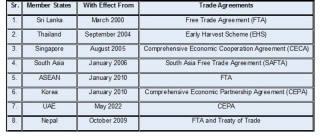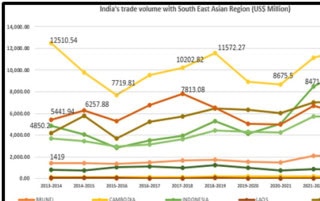Muhammad Umar Farooq Baloch
This insight explores Indian diplomacy with its neighbours, focusing on integrating its foreign policy and economic goals. It emphasises India’s aggressive foreign policy patterns and its concentrated efforts to counter Pakistan, potentially at the expense of regional peace and stability. India’s efforts to counter Pakistan are influenced by several critical factors, including the ongoing great power rivalry between the United States (US) and China, the Sino-India border disputes, the Kashmir dispute, and the US-led Indian role as a ‘net security provider’ in the region.
 India’s foreign policy objectives aim to isolate Pakistan, particularly in trade and economic sectors, under the Indian government’s policies, especially during the Bharatiya Janata Party’s (BJP) rule. This approach reflects the mindset of Modi’s regime and promotes extreme ideologies destabilising regional economic cooperation, besides the non-functional South Asian Association of Regional Cooperation (SAARC).
India’s foreign policy objectives aim to isolate Pakistan, particularly in trade and economic sectors, under the Indian government’s policies, especially during the Bharatiya Janata Party’s (BJP) rule. This approach reflects the mindset of Modi’s regime and promotes extreme ideologies destabilising regional economic cooperation, besides the non-functional South Asian Association of Regional Cooperation (SAARC).
India changed its politico-economic strategies after the end of the Cold War. This involved adopting economic reforms in the early 1990s, deepening ties with the US, and launching the ‘Look East Policy’ (LEP) in 1992, later renamed the ‘Neighbourhood First Policy’. The ‘Act East Policy’ was announced in November 2014 as an upgrade of the LEP and a diplomatic initiative to promote economic, strategic, and cultural relations with the vast Asia-Pacific region at different levels. India sought to enhance economic, trade, and investment engagements to strengthen its role in the neighbourhood through initiatives such as SAARC, Bangladesh-Bhutan-India-Nepal Initiative (BBIN), and South Asian Sub-Regional Economic Cooperation (SASEC). This shift is also in line with the US Indo-Pacific Strategy (IPS), of which the Quadrilateral Security Dialogue (QUAD) group of states is an important part, in which India has a critical role to play on behalf of the US.
India’s Neighbourhood First Policy aims to seize economic opportunities, particularly with the Association of Southeast Asian Nations (ASEAN) and Northeast Asia. Over the last few years, India’s economic connections with ASEAN have grown significantly, as shown in Figure 1. Through trade agreements in goods and services, ASEAN and India have created one of the largest trade areas in the world, with a combined GDP of approximately US$3 trillion and a market of 1.8 billion people. India seeks to exchange over US$80 billion in goods and services with ASEAN members annually.
 India also signed a Free Trade Agreement (FTA) with South Korea in 2009 to increase bilateral trade to US$50 billion by 2030. In 2011, India has strategically signed trade agreements to enhance its economic position. For instance, the Comprehensive Economic Partnership Agreement (CEPA) with Japan aims to eliminate tariffs on various goods and promote investment streams. This is part of India’s broader strategy to develop strategic partnerships with countries like Australia, Japan, South Korea, Vietnam, Malaysia, and Indonesia and enhance cooperation with the Indian Ocean Region (IOR) and the Bay of Bengal Initiatives for Multi-Sectoral Technical and Economic Cooperation (BIMSTEC) members. As reflected in Figure 2, India has signed several bilateral and multilateral trade agreements with these states, each serving a specific economic purpose.
India also signed a Free Trade Agreement (FTA) with South Korea in 2009 to increase bilateral trade to US$50 billion by 2030. In 2011, India has strategically signed trade agreements to enhance its economic position. For instance, the Comprehensive Economic Partnership Agreement (CEPA) with Japan aims to eliminate tariffs on various goods and promote investment streams. This is part of India’s broader strategy to develop strategic partnerships with countries like Australia, Japan, South Korea, Vietnam, Malaysia, and Indonesia and enhance cooperation with the Indian Ocean Region (IOR) and the Bay of Bengal Initiatives for Multi-Sectoral Technical and Economic Cooperation (BIMSTEC) members. As reflected in Figure 2, India has signed several bilateral and multilateral trade agreements with these states, each serving a specific economic purpose.
India’s trade policies have significantly influenced its relations with Pakistan. It has imposed a steep 200% tariff on all imports from Pakistan, making Pakistani goods more expensive in Indian markets. India has also employed non-tariff barriers, such as regulatory requirements and customs, to restrict trade with Pakistan. By revoking Pakistan’s Most Favoured Nation (MFN) status, India has sought to control trade and economic cooperation at global and regional forums. In contrast, India has signed six limited-time Preferential Trade Agreements (PTAs) with states other than Pakistan, including distant states like Afghanistan.
Although India’s foreign trade during the fiscal year 2022-2023 reached US$1.6 trillion, exports to Pakistan were only US$627 million (0.1% of total exports by India), and imports were US$20 million (0.003% of total imports to India). As evident in Figure 3, India has enhanced trade with all SAARC countries, less Pakistan.
India has been proactive in its efforts to isolate Pakistan on the international economic stage. It has sought to influence global and regional forums, such as the United Nations (UN), the Group of 20 (G20), and the Shanghai Cooperation Organisation (SCO). India’s actions to isolate Pakistan are evident in its investments in projects such as Iran’s Chabahar Port, which aim to find alternative routes towards Afghanistan and Central Asia. India has also tried to isolate Pakistan on the international economic fronts, as seen in its efforts to push Pakistan into the ‘grey list’ of the Financial Action Task Force (FATF).
Pakistan envisions improving trade relations with all its neighbours, including India. However, given Indian policies and actions, there is a need for Pakistan to focus on countries in SAARC, less India until India shows willingness. Focusing on the Western neighbourhood, the Economic Cooperation Organization (ECO) also offers trade dividends. It should be the main pillar for nurturing Pakistan’s strategic partnerships and exploring new markets and regional trade networks within and beyond Asia. Moreover, Pakistan’s efforts to strengthen its trade relations with Central Asian Republics (CARs) through initiatives like the Pakistan-Central Asia Trade Corridor (PCATC), also known as the ‘Middle Corridor, show promise. This approach not only promotes regional stability and economic integration but also positions Pakistan as a proactive competitor in the evolving geopolitical landscape of South and Central Asia.
India uses its ‘Neighbourhood First Policy’ as a fundamental tool for developing relations and economic cooperation with neighbouring states. However, India is constantly making efforts to isolate its immediate neighbour, Pakistan. Meanwhile, Pakistan’s pivot to geoeconomics, as mentioned in the National Security Policy (NSP), remains focused on diversifying its trade partners, strengthening economic ties with emerging economies, and pursuing regional cooperation and peace initiatives across the globe. Pakistan has immense potential to enhance trade and economic cooperation with regional partners by establishing alternative routes to access regional and global markets.—Email:[email protected]








